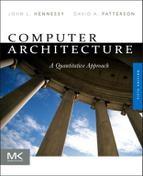Foreword
The first edition of Hennessy and Patterson’s Computer Architecture: A Quantitative Approach was released during my first year in graduate school. I belong, therefore, to that first wave of professionals who learned about our discipline using this book as a compass. Perspective being a fundamental ingredient to a useful Foreword, I find myself at a disadvantage given how much of my own views have been colored by the previous four editions of this book. Another obstacle to clear perspective is that the student-grade reverence for these two superstars of Computer Science has not yet left me, despite (or perhaps because of) having had the chance to get to know them in the years since. These disadvantages are mitigated by my having practiced this trade continuously since this book’s first edition, which has given me a chance to enjoy its evolution and enduring relevance.
The last edition arrived just two years after the rampant industrial race for higher CPU clock frequency had come to its official end, with Intel cancelling its 4 GHz single-core developments and embracing multicore CPUs. Two years was plenty of time for John and Dave to present this story not as a random product line update, but as a defining computing technology inflection point of the last decade. That fourth edition had a reduced emphasis on instruction-level parallelism (ILP) in favor of added material on thread-level parallelism, something the current edition takes even further by devoting two chapters to thread- and data-level parallelism while limiting ILP discussion to a single chapter. Readers who are being introduced to new graphics processing engines will benefit especially from the new Chapter 4 which focuses on data parallelism, explaining the different but slowly converging solutions offered by multimedia extensions in general-purpose processors and increasingly programmable graphics processing units. Of notable practical relevance: If you have ever struggled with CUDA terminology check out Figure 4.24 (teaser: “Shared Memory” is really local, while “Global Memory” is closer to what you’d consider shared memory).
Even though we are still in the middle of that multicore technology shift, this edition embraces what appears to be the next major one: cloud computing. In this case, the ubiquity of Internet connectivity and the evolution of compelling Web services are bringing to the spotlight very small devices (smart phones, tablets) and very large ones (warehouse-scale computing systems). The ARM Cortex A8, a popular CPU for smart phones, appears in Chapter 3’s “Putting It All Together” section, and a whole new Chapter 6 is devoted to request- and data-level parallelism in the context of warehouse-scale computing systems. In this new chapter, John and Dave present these new massive clusters as a distinctively new class of computers—an open invitation for computer architects to help shape this emerging field. Readers will appreciate how this area has evolved in the last decade by comparing the Google cluster architecture described in the third edition with the more modern incarnation presented in this version’s Chapter 6.
Return customers of this book will appreciate once again the work of two outstanding computer scientists who over their careers have perfected the art of combining an academic’s principled treatment of ideas with a deep understanding of leading-edge industrial products and technologies. The authors’ success in industrial interactions won’t be a surprise to those who have witnessed how Dave conducts his biannual project retreats, forums meticulously crafted to extract the most out of academic–industrial collaborations. Those who recall John’s entrepreneurial success with MIPS or bump into him in a Google hallway (as I occasionally do) won’t be surprised by it either.
Perhaps most importantly, return and new readers alike will get their money’s worth. What has made this book an enduring classic is that each edition is not an update but an extensive revision that presents the most current information and unparalleled insight into this fascinating and quickly changing field. For me, after over twenty years in this profession, it is also another opportunity to experience that student-grade admiration for two remarkable teachers.
